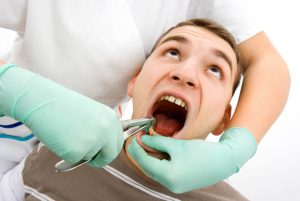How to Prevent Dry Socket after a Tooth Extraction

Other reasons a patient may require a tooth extraction include:
- If a patient has extra teeth
- To create room for other teeth when a patient requires braces
- Wisdom teeth removal
A tooth extraction procedure begins with an X-ray to determine the best way to extract the tooth. There are two different types of tooth extractions: simple extractions and surgical extractions.
Simple Extraction
A simple extraction is performed by a general dentist. This is a type of extraction which is performed on teeth which can be seen inside a patient’s mouth. This procedure involves loosening the tooth with a dental device called an elevator. Once the tooth is loosened, a dentist uses dental forceps to extract the tooth. Simple extractions are performed with a local anesthetic.
Surgical Extraction
This type of extraction is performed if a tooth has been broken, impacted, or lays beneath the surface of a patient’s gums. These types of extractions are performed by oral surgeons and involve cutting into a patient’s gums to remove the tooth. Surgical extraction patients usually receive a local anesthetic, although some procedures require anesthesia through the vein.
What Are the Complications Associated with Tooth Extraction?

There are certain complications that can occur after a tooth extraction. These types of complications include:
- Infection
- Bleeding
- Dry socket
The most common complication that is associated with tooth extraction is dry socket.
What Is Dry Socket?
Dry socket, also known as alveolar osteitis, commonly occurs in the lower jaw or the mandible. It is a painful condition which can occur after a tooth extraction. One common symptom of dry socket includes throbbing pain two to four days after a tooth has been extracted. Dry socket is most common in patients who have had their wisdom teeth removed.
A dry socket occurs when the socket which the tooth has been pulled from is not filled in by a blood clot. This leaves the socket dry, exposing the underlying nerves and causing extreme pain. When this occurs, it needs to be treated immediately. A dentist will clean the wound and place a dressing into the socket to protect it.
If you experience dry socket and are in pain, you can use certain types of anti-inflammatory over-the-counter medications like ibuprofen to help ease the pain and also decrease the swelling.
What Causes Dry Socket?
Dry socket can be caused by many factors. These factors include:
- Bacterial: a pre-existing infection, improper formation of a blood clot, oral bacteria, and more
- Chemical: smoking can increase the risk of dry socket. This is because nicotine can prevent blood clots from forming
- Mechanical: drinking from a straw or spitting can dislodge a blood clot
- Physiological: this includes fluctuations in hormones, poor blood circulation, and more.
What Are the Symptoms of Dry Socket?
If you have developed dry socket, you may notice that the opening of the damaged area is dry and white in color. Pain typically starts about two days after the tooth extraction. You may also notice that you have developed an unpleasant taste in your mouth. You may even develop bad breath. Other symptoms of dry socket include:
- Severe pain at the extraction site
- Pain or discomfort in the jaw, eyes, ears or temple
- Swollen glands
- Low-grade fever
How Do I Prevent Dry Socket After a Tooth Extraction?

To prevent dry socket from occurring, you should avoid spitting or drinking through a straw after a tooth extraction and eat soft food for 24–48 hours after your extraction.
To prevent or avoid dry socket after your tooth extraction, you should also be sure to take the necessary steps in preparing for your tooth extraction. Do not smoke before your tooth is removed, and be sure to maintain a strict oral health care routine in the days leading up to the extraction. It is also imperative that you follow your dentist’s post-op instructions to reduce your risk of dry socket.
Some other tips to prevent dry socket include:
- Proper use of an oral rinse
- Rinse mouth with salt water after eating (do not spit)
- Do not touch the wound
- Avoid eating things like popcorn, pasta or anything else that can easily leave food particles in your mouth
- Avoid drinking carbonated drinks
- Speak to your dentist about medications or prescriptions you are taking before the procedure occurs
What Is the Treatment for Dry Socket after Tooth Extraction?
Dry socket treatment involves irrigating the socket with a sterile saline or oral antibacterial rinse. Once this is done, an oral surgeon will fill the area with protective medicated dressing to stop the pain and allow the healing process to begin. The paste is then reapplied every few days. You will also likely be prescribed antibiotic medications and anti-inflammatory medications.
Your oral surgeon will give you instructions on how to keep the affected area clean and will also advise you that you must maintain a strict oral health care routine to prevent infection. If you experience any pain or discomfort in the days following your extraction, be sure to contact your dentist or a book a follow-up appointment.
Relate Posts to Read:
Is Smoking after Tooth Extraction Okay?
Medically Fact-Checked & Written by Our Dental Editorial Team
You can read more about our editorial guidelines by clicking this link and learn more about the Emergency Dentists USA editorial team here.


